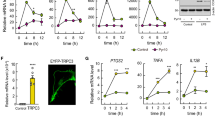Abstract
UNC93B1 is involved in the delivery of nucleotide-sensing Toll-like receptors (TLR) including TLR9 to endolysosomes. However, possible functions of UNC93A, another member of the UNC-93 superfamily, have not been studied in the context of TLR signaling. Here, we injected naked CpG-ODNs or liposome-encapsulated CpG-ODN (Lipoplex(O)) into the BALB/c mouse peritoneal cavity and investigated expression of mouse UNC93B1 and UNC93A genes in the peritoneal cells. UNC93A mRNA expression was increased by Lipoplex(O) in a time-dependent manner, whereas the expression level of UNC93B1 was not changed. To evaluate whether the expression of UNC93A involves TLR9, TLR9 knock out (TLR-/-) mice were injected with Lipoplex(O) or LipoplexGC(O), and the peritoneal cells were analyzed. The expression of UNC93A was not induced by Lipoplex(O) in TLR9-/- mice. These results suggest that UNC93A is closely associated with TLR9 signaling induced by Lipoplex(O) in the peritoneal cells in vivo. Primary cells including peritoneal cells stimulated with CpG-ODNs, Lipoplex(O), and several cytokines in vitro were prepared. However, UNC93A expression was not induced by any stimulation. To identify cellular localization of UNC93A, human embryonic kidney 293 cells stably expressing UNC93A were established and analyzed by confocal microscopy. The human and mouse UNC93A proteins were detected in the cytoplasm. Further investigation of the UNC93A function related with the CpG-DNA-mediated immune response may provide information to support efficient application of CpG-DNA immunotherapeutics.
Similar content being viewed by others
References
Aderem A and Ulevitch RJ (2000) Toll-like receptors in the induction of the innate immune response. Nature 406, 782–787
Akira S, Takeda K, and Kaisho T (2001) Toll-like receptors: critical proteins linking innate and acquired immunity. Nat Immunol 2, 675–680.
Akira S, Uematsu S, and Takeuchi O (2006) Pathogen recognition and innate immunity. Cell 124, 783–801.
Ballas ZK, Rasmussen WL, and Krieg AM (1996) Induction of NK activity in murine and human cells by CpG motifs in oligodeoxynucleotides and bacterial DNA. J Immunol 157, 1840–1845.
Bode C, Zhao G, Steinhagen F, Kinjo T, and Klinman DM (2011) CpG DNA as a vaccine adjuvant. Expert Rev Vaccines 10, 499–511.
Brinkmann MM, Spooner E, Hoebe K, Beutler B, Ploegh HL, and Kim YM (2007) The interaction between the ER membrane protein UNC93B and TLR3, 7, and 9 is crucial for TLR signaling. J Cell Biol 177, 265–275.
Carson DA and Raz E (1997) Oligonucleotide adjuvants for T helper 1 (Th1)-specific vaccination. J Exp Med 186, 1621–1622.
Chu RS, Targoni OS, Krieg AM, Lehmann PV, and Harding CV (1997) CpG oligodeoxynucleotides act as adjuvants that switch on T helper 1 (Th1) immunity. J Exp Med 186, 1623–1631.
Ishii KJ, Coban C, Kato H, Takahashi K, Torii Y, Takeshita F et al. (2006) A Toll-like receptor-independent antiviral response induced by doublestranded B-form DNA. Nat Immunol 7, 40–48.
Iwasaki A and Medzhitov R (2004) Toll-like receptor control of the adaptive immune responses. Nat Immunol 5, 987–995.
Kanzler H, Barrat FJ, Hessel EM, and Coffman RL (2007) Therapeutic targeting of innate immunity with Toll-like receptor agonists and antagonists. Nat Med 13, 552–559.
Kawane K, Ohtani M, Miwa K, Kizawa T, Kanbara Y, Yoshioka Y et al. (2006) Chronic polyarthritis caused by mammalian DNA that escapes from degradation in macrophages. Nature 443, 998–1002.
Kim D, Kwon HJ, and Lee Y (2011a) Activation of Toll-like receptor 9 and production of epitope specific antibody by liposome-encapsulated CpGDNA. BMB Rep 44, 607–612.
Kim D, Kwon S, Rhee JW, Kim KD, Kim YE, Park CS et al. (2011b) Production of antibodies with peptide-CpG-DNA-liposome complex without carriers. BMC Immunol 12:29.
Kim D, Lee Y, and Kwon HJ (2013) Expression of IFN-g induced by CpGDNA stimulation in a human myeloid leukemia cell line KG-1. J Korean Soc Appl Biol Chem 56, 553–558.
Kim D, Rhee JW, Kwon S, Sohn WJ, Lee Y, Kim DW et al. (2009) Immunostimulation and anti-DNA antibody production by backbone modified CpG-DNA. Biochem Biophys Res Commun 379, 362–367.
Kim YM, Brinkmann MM, Paquet ME, and Ploegh HL (2008) UNC93B1 delivers nucleotide-sensing toll-like receptors to endolysosomes. Nature 452, 234–238.
Klinman DM, Yi AK, Beaucage SL, Conover J, and Krieg AM (1996) CpG motifs present in bacteria DNA rapidly induce lymphocytes to secrete interleukin 6, interleukin 12, and interferon-ã. Proc Natl Acad Sci U S A 93, 2879–2883.
Krieg AM (2006) Therapeutic potential of Toll-like receptor 9 activation. Nat Rev Drug Discov 5, 471–484.
Krieg AM, Yi AK, Matson S, Waldschmidt TJ, Bishop GA, Teasdale R et al. (1995) CpG motifs in bacterial DNA trigger direct B-cell activation. Nature 374, 546–549.
Kumagai Y, Takeuchi O, and Akira S (2008) TLR9 as a key receptor for the recognition of DNA. Adv Drug Deliv Rev 60, 795–804.
Lee KW, Jung J, Lee Y, Kim TY, Choi SY, Park J et al. (2006) Immunostimulatory oligodeoxynucleotide isolated from genome wide screening of Mycobacterium bovis chromosomal DNA. Mol Immunol 43, 2107–2118.
Liu Y, Dodds P, Emilion G, Mungall AJ, Dunham I, Beck S et al. (2002) The human homologue of unc-93 maps to chromosome 6q27 — characterization and analysis in sporadic epithelial ovarian cancer. BMC Genet 3:20.
Medzhitov R and Janeway C Jr (2000) Innate immunity. N Engl J Med 343, 338–344.
Messina JP, Gilkeson GS, and Pisetsky DS (1991) Stimulation of in vitro murine lymphocyte proliferation by bacterial DNA. J Immunol 147, 1759–1764.
Okabe Y, Kawane K, Akira S, Taniguchi T, and Nagata S (2005) Toll-like receptor-independent gene induction program activated by mammalian DNA escaped from apoptotic DNA degradation. J Exp Med 202, 1333–1339.
Park MC, Kim D, Lee Y, and Kwon HJ (2013) CD83 expression induced by CpG-DNA stimulation in a macrophage cell line RAW 264.7. BMB Rep 46, 448–453.
Author information
Authors and Affiliations
Corresponding author
Rights and permissions
About this article
Cite this article
Kim, T.H., Kim, D., Lee, Y. et al. Expression of UNC93A induced by CpG-DNA-liposome complex in mice. J Korean Soc Appl Biol Chem 57, 281–287 (2014). https://doi.org/10.1007/s13765-014-4050-z
Received:
Accepted:
Published:
Issue Date:
DOI: https://doi.org/10.1007/s13765-014-4050-z




